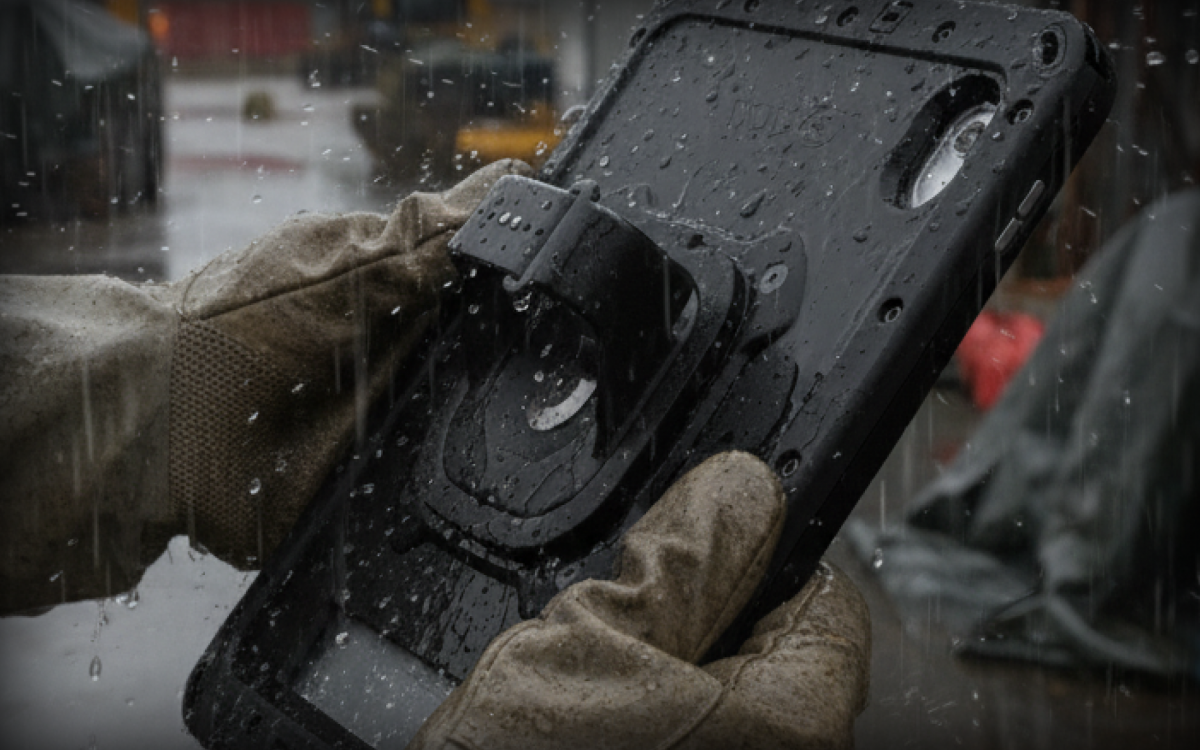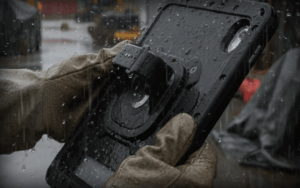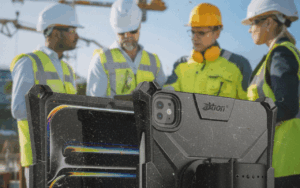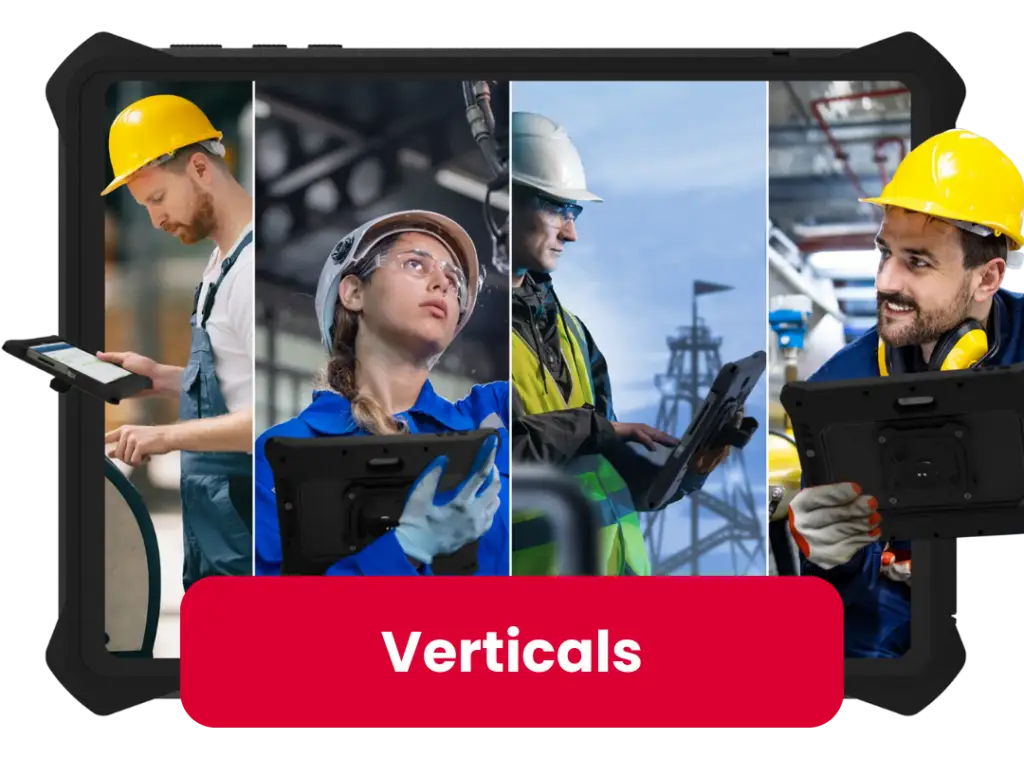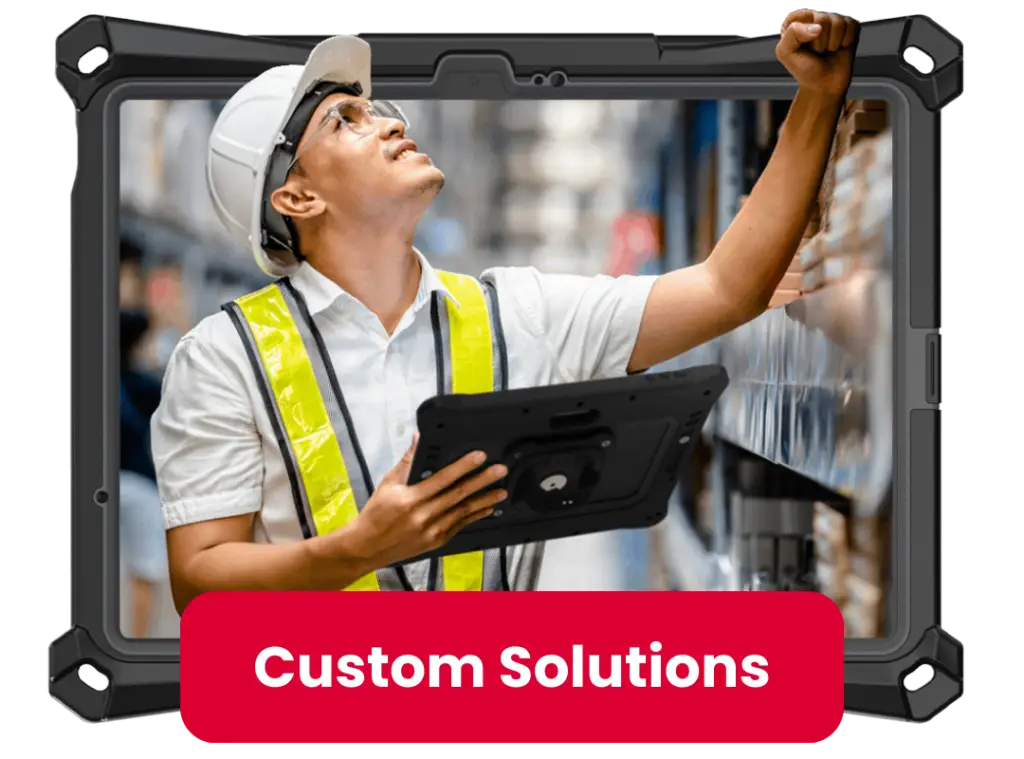Picture this: you’re a nurse on a busy hospital floor, where accidental spills are a part of the daily routine. Or maybe you’re at a construction site, with dust swirling everywhere as a sudden downpour begins. In these moments, your tablet isn’t just a gadget; it’s your lifeline for communication, data, and getting the job done. How do you know it can survive the challenges of your world?
The answer lies in a secret code, a universal “toughness score” for electronics called an IP Rating. This isn’t just a marketing buzzword; it’s a globally recognized scientific standard that tells you exactly how well a device is protected against solids like dust and liquids like water.
This guide will teach you how to read this code. By the time you finish, you will understand exactly what those numbers on your phone or tablet case mean, why they are so important, and how to choose the right gear to protect your valuable technology.
Chapter 1: What Is an IP Rating? Your Guide to the Global Standard
Have you ever seen a product labeled “water-resistant” and wondered what that really means? Can it handle a splash, a rainstorm, or a drop in the pool? Without a clear standard, these terms can be confusing and even misleading. That’s where IP ratings come in.
The letters “IP” stand for Ingress Protection. “Ingress” is just a technical word for “getting in.” So, an IP rating is a grade that tells you how good a device’s case, or “enclosure,” is at keeping things out. The “things” it keeps out are divided into two categories: solids (like dirt, sand, and dust) and liquids (almost always water).
This rating system isn’t something companies make up themselves. It is a global standard created and managed by the International Electrotechnical Commission, or IEC. The IEC is a worldwide organization that creates the official rules for electrical and electronic technologies to make sure they are safe and work together properly. The specific “rulebook” for these toughness scores is called IEC 60529.
The existence of this single, global standard is incredibly important. It ensures that an IP67 rating from a company in the United States means the exact same thing as an IP67 rating from a company in Europe or Asia. This creates a trustworthy system that helps businesses trade products around the world and gives you, the customer, real confidence in what you are buying. As the IEC itself states, (https://www.iec.ch/ip-ratings). This standard replaces vague promises with clear, testable, and reliable facts.
Chapter 2: How to Read an IP Code: Cracking the Two-Digit Secret
At first glance, a code like “IP67” might look complicated, but it’s actually very simple once you know the secret. The code is always made up of the letters “IP” followed by two characters.
| IP | First Character | Second Character |
| Stands for Ingress Protection | Protection against solids (dust, dirt, etc.) | Protection against liquids (water) |
The first number tells you how well the device is protected from solid objects, and the second number tells you how well it’s protected from water. The rule is simple: the higher the number, the better the protection.
The First Digit (Solids): From Hands to Harmful Dust (0-6)
This number, which ranges from 0 to 6, describes the size of the solid object the enclosure can block. It covers everything from a person’s hand to microscopic dust particles.
IP0X: No protection from solids at all.
IP1X: Protects against objects larger than 50 mm. This means you couldn’t accidentally touch the internal parts with the back of your hand.
IP2X: Protects against objects larger than 12.5 mm. This is about the size of an adult finger, making it a common minimum requirement for indoor electronics to prevent shocks.
IP3X: Protects against objects larger than 2.5 mm. This includes most tools, like a screwdriver, and thick wires.
IP4X: Protects against objects larger than 1 mm. This level can stop small screws, most wires, and even large insects from getting inside.
IP5X: This level is considered “dust protected.” A very small amount of dust might get inside the enclosure, but it will not be enough to damage the electronics or interfere with how they work.
IP6X: This is the highest level of protection against solids. It is “dust tight,” meaning absolutely no dust can get in, even after being exposed to it for a long time. This is the level you want for devices used in very dusty places like construction sites, farms, or deserts.
The Second Digit (Liquids): From Drips to Deep Dives (0-9K)
The second number is all about water resistance. It ranges from 0 to 9K and describes the level of protection from simple drips to high-pressure, hot steam jets. Each level involves a specific test with rules for water pressure, volume, and time.
IPX0: No protection from water.
IPX1: Protects against vertically dripping water. This is like the condensation that might drip inside a cool building.
IPX2: Protects against dripping water when the device is tilted up to 15 degrees. It can handle drips coming from a slight angle.
IPX3: Protects against spraying water. Imagine water from a spray bottle hitting the device from any angle up to 60 degrees from straight up.
IPX4: Protects against splashing water from any direction. This is a common rating for devices that need to be rain-resistant or can handle splashes by the pool.
IPX5: Protects against low-pressure water jets. This is like being sprayed with a garden hose from any direction.
IPX6: Protects against powerful, high-pressure water jets. This is a much stronger spray, like one you might see on a ship’s deck or during an industrial wash-down.
IPX7: Protects the device when it is submerged (dipped) in water up to 1 meter (about 3.3 feet) deep for 30 minutes.
IPX8: Protects the device when it is submerged in water deeper than 1 meter. For this rating, the manufacturer must state the exact depth and the amount of time it can stay underwater. For example, a company might say their device is rated IP68 for up to 3 meters for 60 minutes.
IPX9K: This is a special, high-level rating that protects against powerful, high-pressure, high-temperature water and steam jets. It’s designed for equipment that needs to be deep cleaned and sanitized, like in food processing factories or on heavy machinery.
What Does the “X” Mean?
Sometimes you will see a rating like IPX7 or IP6X. The “X” is simply a placeholder. It means the manufacturer did not perform the test for that category.
IPX7 means the device was tested for water submersion (level 7) but was not tested for protection against dust.
IP6X means the device is dust-tight (level 6) but was not tested for protection against water. An “X” does not mean the device has zero protection, it just means there is no official test score for it.
What About the Extra Letters?
In some rare cases, you might see an extra letter after the numbers, like IP66W. These supplementary letters provide extra information about the test or the device’s protection.
M: The device was moving during the water test (for example, a spinning motor).
S: The device was standing still during the water test.
W: The device is protected against specific weather conditions.
H: The device is a high-voltage apparatus.
It is also important to understand that the water protection levels are not always all-inclusive. A device rated IPX7 for submersion is tested for its ability to withstand the static pressure of being still underwater. This is a very different test from IPX6, which tests against the dynamic force of a powerful water jet. Because of this, a device’s seals might hold up perfectly when submerged but could fail if hit with a direct, high-pressure blast. For this reason, some products that are protected against both will list two ratings, such as IP66/IP68, to show they have passed both tests.
Chapter 3: The Complete IP Rating Chart (Simplified)
To make it easy to understand what each number means, here is a simple chart. You can use it to quickly look up the protection level of any device. Just find the first digit in the left columns for solid protection and the second digit in the right columns for liquid protection.
| First Digit (Solids) | Protects Against… (Simple Explanation) | Second Digit (Liquids) | Protects Against… (Simple Explanation) |
| 0 | No protection | 0 | No protection |
| 1 | Large body parts, like the back of a hand | 1 | Dripping water (like condensation) |
| 2 | Fingers or similar-sized objects | 2 | Dripping water when tilted at an angle |
| 3 | Tools and thick wires (over 2.5 mm) | 3 | Spraying water (like a spray bottle) |
| 4 | Most wires, screws, and large insects (over 1 mm) | 4 | Splashing water from any direction (like rain) |
| 5 | Most dust (dust protected, limited amount may enter) | 5 | Low-pressure water jets (like a garden hose) |
| 6 | All dust (completely dust tight) | 6 | Powerful, high-pressure water jets |
| 7 | Short time underwater (up to 1 meter for 30 min) | ||
| 8 | Long time underwater (deeper than 1 meter) | ||
| 9K | Powerful, high-temperature steam jets |
Chapter 4: The Most Common IP Ratings in Your Life
While there are many possible combinations of IP ratings, you are most likely to see a few common ones on the products you use every day, at home and at work. Understanding these will help you make smarter choices about the technology you buy and how you protect it.
IP54: Good for Indoor Work Environments
A device with an IP54 rating is protected from most dust (level 5) and can handle splashing water from any direction (level 4). While not fully dust-tight or submersible, this level of protection is often sufficient for equipment used indoors in places like manufacturing facilities or control rooms. It ensures that airborne dust won’t cause damage and that an accidental splash from a spilled drink won’t cause a failure.
IP65: Ready for the Outdoors and Light Wash-Downs
When you see an IP65 rating, you know the device is completely dust-tight (level 6) and can withstand low-pressure water jets, like from a garden hose (level 5). This makes it a great choice for outdoor electrical boxes, security cameras, or industrial computers on a factory floor that might be sprayed down for cleaning. It can handle rain and cleaning, but it is not designed to be submerged in water.
IP67 vs. IP68: The Rugged Showdown
For anyone who needs a truly rugged device that can survive serious encounters with water, the choice often comes down to IP67 and IP68. These are the top-tier ratings for most consumer and professional electronics, and understanding the small but crucial difference between them is key.
IP67: The “Dunk-Proof” Rating. A device with an IP67 rating is completely dust-tight (level 6) and can survive being temporarily submerged in up to 1 meter (about 3.3 feet) of static water for up to 30 minutes. This is the ideal rating for protecting against accidents. If you drop your IP67-rated tablet in a sink, a puddle, or even the shallow end of a pool and grab it quickly, it should be perfectly fine. It’s built to survive the “oops” moments.
IP68: The “Submersible” Rating. A device with an IP68 rating is also completely dust-tight (level 6), but it offers a higher level of water protection. It can survive being submerged in water deeper than 1 meter for an extended period. The most important thing to know about IP68 is that the manufacturer must specify the exact test conditions. One brand’s IP68 phone might be rated for 1.5 meters for 30 minutes, while a rugged tablet from another company might be rated for 3 meters for 60 minutes. This rating is designed for situations where a device might be underwater for a long time or used in very wet environments continuously.
The choice between these two often comes down to balancing need and cost. A higher level of protection often means a more expensive and complex design. For a construction worker who needs protection from rain and accidental drops in mud puddles, IP67 is likely perfect. However, for a marine biologist who uses a tablet on a boat where it could fall into deep water, the superior protection of IP68 is a necessary investment.
| Feature | IP67 | IP68 |
| Dust Protection | Complete / Dust Tight | Complete / Dust Tight |
| Water Protection | Temporary Dunk (up to 1 meter for 30 minutes) | Continuous Submersion (deeper than 1 meter, manufacturer specifies depth and time) |
| Best For | Accidental drops in water, heavy rain, splashes | Intentional or prolonged time underwater, extremely wet environments |
| Think of it as… | “Oops, I dropped it in the water!” | “I’m working in or around deep water.” |
IP69K: The Industrial Powerhouse
The IP69K rating is in a class of its own. It signifies that a device is not only dust-tight (level 6) but can also withstand being cleaned with powerful, high-pressure, high-temperature steam jets. This level of protection is essential in industries where perfect hygiene and sanitation are mandatory, such as food and beverage processing, pharmaceutical manufacturing, and heavy vehicle production. Equipment in these environments must be regularly blasted with hot water and chemicals to keep them sterile, and only an IP69K-rated enclosure can survive that kind of treatment day after day.
Chapter 5: The “Waterproof” Myth: What Your Device’s IP Rating Doesn’t Tell You
One of the biggest sources of confusion around IP ratings is the word “waterproof.” Many people see a high rating like IP68 and assume their device is completely invincible to water, but that is not the case. In the world of engineering, there is a big difference between “water-resistant” and “waterproof.”
“Waterproof” implies that something is impervious to water forever, under any conditions. In reality, very few things are truly waterproof. “Water-resistant,” on the other hand, means that a device can resist water getting inside under very specific, tested conditions. An IP rating is a precise measure of water resistance, not a guarantee of being waterproof.
There are a few critical things that an IP rating does not cover, and knowing them can save you from a very expensive accident.
Lab Conditions vs. The Real World
IP rating tests are performed in a highly controlled laboratory setting. The liquid used in these tests is almost always pure, fresh water. This means an IP rating does not guarantee protection against other types of liquids you might encounter in the real world, such as:
Saltwater at the beach, which is highly corrosive and can damage seals and electronics.
Chlorinated water in a swimming pool, which can also degrade the rubber gaskets that keep water out.
Other common liquids like coffee, soda, juice, or cleaning chemicals.
Furthermore, the submersion tests (IPX7 and IPX8) are done in static, or still, water. They do not simulate the dynamic force of moving water. This means your IP68 phone might survive being submerged in a 2-meter deep pool, but the rating doesn’t guarantee it will survive a fall while water skiing or being hit by a powerful wave at the beach.
Protection Is Not Permanent
This is perhaps the most important concept to understand: a device’s water resistance is a depreciating asset. The high IP rating your device has on the day you buy it is not the same level of protection it will have a year or two later.
Inside every water-resistant device are tiny rubber gaskets, seals, and adhesives that create a barrier against dust and water. These components are fragile. Over time, a device’s protection is weakened by normal wear and tear.
Everyday Use: Every time you drop your device, even from a short height, the impact can create microscopic gaps in the seals.
Temperature Changes: Moving from a cold, air-conditioned office to a hot car can cause the materials in the device to expand and contract, which can stress and weaken the seals over time.
Physical Damage: Even a tiny, hairline crack in the screen or the back of the device can completely destroy its water resistance. That crack becomes an open door for water to get straight to the sensitive electronics inside.
The teardown experts at iFixit have shown that the internal seals responsible for water resistance are often just thin strips of adhesive and tiny rubber rings. They are a great first line of defense, but they are not designed to last forever or withstand repeated abuse. This creates a “protection gap” that grows over the life of your device. The older and more used your device is, the less you can rely on its original IP rating. This is why a high-quality, external protective case is so important. A case’s IP rating is independent of the device’s condition. If the case gets damaged, it can be replaced, restoring full protection for a fraction of the cost of a new device.
Chapter 6: Why IP Ratings Are a Bigger Deal Than You Think (The Billion-Dollar Problem)
Protecting our devices from dust and water isn’t just about convenience; it’s about avoiding a massive and growing financial risk. The cost of damaged electronics is staggering, and an IP rating is one of the most effective tools for preventing these expensive failures.
The Scale of the Problem
The number of damaged devices is almost hard to believe. According to data from Allstate Protection Plans,(https://www.pcmag.com/news/be-careful-these-are-the-most-common-types-of-smartphone-damage). While cracked screens are the most common issue, water damage remains a major problem. In 2023, water damage was still responsible for 21% of all smartphone accidents and malfunctions.
The total cost of these accidents is enormous. Research from SquareTrade, a protection plan provider, found that water damage costs phone users billions of dollars each year. This is because a single incident can easily lead to a repair bill of hundreds of dollars.
The High Cost of Failure
If your device does suffer from water damage, the cost to fix it can be significant. The exact price depends on the phone model and the severity of the damage, but the expenses add up quickly.
The average cost for all types of smartphone repairs and replacements has now reached $302.
For water damage specifically, the repair cost for an iPhone can range from $70 to over $400.
For Android phones, the cost is typically between $50 and $250.
Often, the damage isn’t immediately obvious. A device might seem to work fine right after getting wet, but moisture trapped inside can lead to “delayed corrosion.” This is a slow-moving chemical reaction that can destroy the tiny circuits inside your device over days or even weeks. You might start to notice strange issues like “phantom” screen touches, a battery that drains very quickly, or a camera lens that is always foggy. By the time these symptoms appear, the damage is often widespread and much more expensive to fix.
Myth Busting: The Rice Trick Does Not Work
One of the most common myths about saving a wet phone is to put it in a bag of uncooked rice. While this is a popular piece of advice, it is not effective and can even cause more harm.
Scientific tests have shown that leaving a phone in rice for 48 hours only removes about 13% of the internal moisture.
Both Apple and Samsung officially warn against using rice. They state that small particles of dust and starch from the rice can get into the charging port and other openings, causing clogs and further damage.
The best thing to do with a wet device is to turn it off immediately, gently tap it with the port facing down to remove excess water, and place it in a dry area with good airflow, perhaps with a fan pointed at it. However, the best strategy of all is prevention. Understanding IP ratings and using a high-quality protective case is the most effective way to avoid this entire situation.
Chapter 7: IP Ratings at Work: Protecting Mission-Critical Tech
While most people think of IP ratings in the context of their personal phones and tablets, these standards are even more critical in professional environments. In industries like healthcare, manufacturing, and logistics, device failure is not just an inconvenience—it can lead to lost productivity, safety hazards, and huge financial losses. For these users, a high IP rating is a non-negotiable requirement.
In Healthcare: Ensuring Safety and Sanitation
In hospitals, clinics, and other medical settings, electronic devices must be both reliable and cleanable. Patient safety is the number one priority, and a malfunctioning device can have life-threatening consequences. For example, if an infusion pump fails due to liquid getting inside, it could deliver the wrong dose of medication.
IP ratings are crucial for ensuring that medical equipment can withstand the rigors of a healthcare environment. Devices are constantly exposed to bodily fluids, cleaning solutions, and sanitizing agents. A strong IP rating, such as IP65 or higher, ensures that a device can be wiped down and disinfected repeatedly without risk of failure. For equipment that may need to be submerged during sterilization cycles, an IP67 or IP68 rating is often required. Regulatory bodies like the FDA in the U.S. and those governing CE Marking in Europe require that medical devices meet strict safety standards, and resistance to environmental factors is a key part of that compliance.
On the Factory Floor and In Logistics
Industrial environments are notoriously tough on electronics. Devices like panel PCs, tablets, and scanners are exposed to a constant barrage of dust, oil, moisture, chemicals, and vibrations. In these settings, a standard consumer-grade device would fail very quickly.
An IP65 rating is often considered the minimum for industrial use. This ensures the device is completely sealed against dust and can be sprayed with low-pressure water jets during cleaning.
In the food processing and pharmaceutical industries, hygiene standards are extremely high. Equipment must undergo daily, high-pressure wash-downs with hot water and sanitizing chemicals. For these applications, an IP68 or even an IP69K rating is mandatory to ensure the device can survive the intense cleaning process without failing.
For these businesses, investing in rugged, high-IP-rated devices is a smart financial decision. A broken panel PC on an assembly line can shut down the entire production process, costing a company thousands of dollars for every minute of downtime. A reliable, properly-rated device prevents these costly interruptions and keeps operations running smoothly.
In the Field: Reliability in Uncontrolled Environments
For professionals who work outdoors, such as construction workers, utility technicians, field engineers, surveyors, and military personnel, their technology must be able to survive whatever the environment throws at it. These users work in rain, snow, mud, and dust, and their devices need to be just as tough as they are.
An IP67 rating is often a key requirement for field devices. It guarantees the device is dust-tight and can survive being dropped in a puddle, a muddy trench, or a snowbank for up to 30 minutes.
In addition to IP ratings, devices for these fields are often tested against military standards like MIL-STD-810. This standard includes a series of tests for other environmental factors that IP ratings do not cover, such as shock from drops, vibration from being mounted in a vehicle, extreme temperatures, and high altitudes.
For these professionals, a rugged device is not a luxury; it is an essential tool. A device failure in the field can mean a lost day of work, compromised data, or even a safety risk. A high IP rating provides the peace of mind that their technology will be there when they need it most.
Chapter 8: Your IP Rating Questions, Answered (FAQ)
Even with all this information, you might still have a few questions. Here are answers to some of the most frequently asked questions about IP ratings.
What if a rating has an ‘X’ (e.g., IPX4)?
The ‘X’ is a placeholder and simply means the product was not tested for that specific type of protection. In the case of IPX4, it means the device was tested to resist splashing water (level 4) but was not submitted for a dust protection test. It does not mean it has zero protection against dust, only that it does not have an official rating for it.
Is IP67 or IP68 “waterproof”?
No. These devices are highly water-resistant under specific, controlled conditions. The term “waterproof” is misleading because it implies total and permanent invincibility to water, which is not accurate for electronics. Always think of it as resistance for a certain depth and time.
Can I take my IP68 phone swimming?
It is generally not recommended. IP ratings are tested using fresh water. The chemicals in a chlorinated pool or the salt in ocean water can be corrosive and damage the seals that protect your device over time. Additionally,(https://www.jabra.com/blog/waterproof-or-water-resistant-whats-behind-an-ip-rating/), so features like listening to music with wireless earbuds will not work reliably underwater.
Does an IP rating last forever?
No, it does not. The protection offered by an IP rating can and does degrade over time. The small seals and adhesives that keep water and dust out can wear down with age, temperature changes, and physical damage like drops and bumps. A two-year-old phone that has been dropped a few times will not have the same level of water resistance it had when it was new.
Is a higher IP rating always better?
Not necessarily. The best IP rating is the one that is appropriate for your environment. An IP69K-rated case is fantastic for a food processing plant but is complete overkill (and needlessly expensive) for someone who just needs protection from rain on their daily commute. Choosing the right rating for your needs is the smartest and most cost-effective approach.
Where can I learn more about the engineering behind this?
For engineers, product designers, and anyone who wants a much deeper technical understanding, a key resource is the book (https://www.barnesandnoble.com/w/designing-electronic-product-enclosures-tony-serksnis/1127953034) by Tony Serksnis. This text provides a detailed look at how enclosures are designed and built to meet these standards, covering everything from materials science and heat transfer to shock, vibration, and regulatory compliance.
Conclusion: Choose Your Protection Wisely
IP ratings are more than just a set of technical numbers; they are a clear, reliable, and global language for toughness. Understanding this language empowers you to make informed decisions about the technology you rely on every day.
We have learned that “IP” stands for Ingress Protection and that the two digits in the code tell you exactly how well a device is shielded from solids and liquids. We have also seen that while a device’s built-in IP rating is a great first line of defense, it is not a permanent feature. It weakens with age and use, leaving your valuable electronics increasingly vulnerable. As one expert on rugged design states:
“In harsh environments, conventional computers are susceptible to damage from dust, moisture, vibrations, temperature fluctuations, and impacts. Their fragility limits their effectiveness and compromises reliability, hindering productivity and endangering critical operations. This highlights the pressing need for rugged design, where robustness and durability take centre stage” (https://www.milcomputing.com/why-is-rugged-design-helpful-to-enhance-the-power-of-computing/).
True, long-lasting peace of mind comes from a dedicated, rugged case that provides its own certified layer of protection. This external shield is your insurance policy against the drops, spills, and dust of the real world.
Now that you’re an IP rating expert, you can choose your protection with confidence.
Explore The Joy Factory’s range of certified rugged and water-resistant cases to find the perfect shield for your device.
Enable Productivity.
TAKE AXTION.
Explore The Joy Factory's range of certified rugged and water-resistant cases to find the perfect shield for your device.
EXPLORE SOLUTIONS
